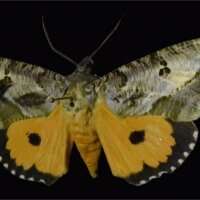Like moths to a colorful flame

A nocturnal moth may be using its colorful wing patterns to attract a female mate, according to new research led by The University of Western Australia and the Adolphe Merkle Institute in Switzerland.
Animals that are active at night are thought to rely on senses other than vision, such as smell and vibrations but the new study has discovered a nocturnal moth with wing patterns that produce some highly unusual optical effects.
Lead author Jennifer Kelley, an ARC Future Fellow in UWA's School of Biological Sciences, said that the study, published today in Current Biology, was based on a serendipitous discovery at the Western Australian Museum.
"Iridescent colors—those that change with viewing angle—are commonly observed in butterflies and hummingbirds that fly during the day and use these colors for signaling, such as during courtship," Dr. Kelley said.
"This study is the first to find angle-dependent coloration in a nocturnal species, the Dot-underwing moth (Eudocima materna)."
Male moths were found to have three dark patches on each forewing that changed in size and darkness depending on the viewing angle, causing a shape-shifting effect. In females, the whole surface of the forewing darkens with changing angle.
Sex differences in coloration typically evolve when males try to attract females using their flamboyant colors and courtship rituals. However, visual courtship behaviours are not known in nocturnal moths, which are considered to rely on pheromones for communication.
The team of biologists and physicists was able to reveal that these optical special effects are produced using specialized scales in the wings—a clever directional reflection coating straight from nature's toolbox of biological nanoengineered materials.
When viewed directly from above, these scales behave like mirrors, giving the wings a sparkly appearance. However, when the wing is viewed at an angle, an underlying layer of darker scales becomes visible, producing the dark wing patches in males.
Dr. Bodo Wilts, group leader at the Adolphe Merkle Institute, said the power of optical nanostructures was that they could bend light at will.
"This often results in optical effects that cannot be achieved with pigments," Dr. Wilts said. "Evolution has provided a diversity of mechanisms in insects, highlighting nature's ability to bio-engineer nanostructures. The moth's nanostructures are first of a kind to be described in night-flying insects and create this stunning visual effect."
Dr. Kelley said some moths were known to rapidly beat their wings before approaching a female.
"If this occurs in the Dot-underwing moth, the male's wing patches would appear to flash on and off, which could be highly attractive to females," she said. "However, we know very little about this species of moth, so the next step is to study its courtship rituals.
"As humans, we have tended to assume that other animals sense the world in the same way that we do. However, we now know that many animals have visual systems, including night vision, that far surpass our own.
"This raises fascinating new questions about how animal visual signals are optimized for transmission and reception in the dark. Future studies on how animals communicate in the dark will further our understanding of the evolution of vision, with the potential to also inspire novel optical technologies."
More information: Jennifer L. Kelley et al. A Dynamic Optical Signal in a Nocturnal Moth, Current Biology (2019). DOI: 10.1016/j.cub.2019.07.005
Journal information: Current Biology
Provided by University of Western Australia



















